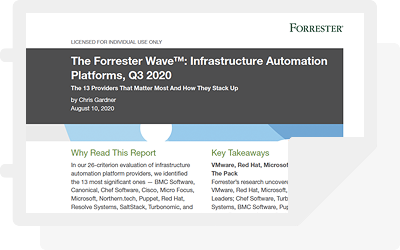Several decades ago, virtualization was introduced to transform the way IT infrastructure resources were consumed. The logical abstraction between the physical hardware and the software resources allows organizations to improve IT service performance. Since then, the industry has evolved and now experiences unprecedented demands pertaining to service availability, flexibility and security, among other attributes of the modern IT infrastructure. Increasing dependence on technology to reach end-users and customers has forced vendors to find new and effective ways to meet high standards of Service-Level Agreements (SLAs).
Software-Defined Infrastructure (SDI) has emerged as a promising approach to address the extensive demands on maximizing the value potential of infrastructure deployments. SDI refers to the operation and control of IT infrastructure entirely using software technologies and without involvement of the human element. Processes including infrastructure control, management, provisioning, configuration and other architectural operations are performed automatically via software as per application requirements and the defined operational policies. Since the changes are not dependent or limited to the human involvement, SDI enables intelligent infrastructure processes based on the changing IT operation requirements in real-time. The IT infrastructure therefore becomes intelligent, taking smart decisions on its own in order to meet the defined goals on SLAs, performance, security and other considerations. SDI allows the infrastructure to operate as a self-aware, self-healing, self-scaling and self-optimizing IT environment to enable truly agile business processes.
The Software-Defined Infrastructure stack typically comprises of the following components:
- Physical Infrastructure: At the machine level, SDI comprises of the hardware resources such as servers and networking devices, as well as firmware, hypervisors and other endpoint terminals. The infrastructure components may be scaled on an ongoing basis to address changing IT needs, while the SDI functionality can encompass the expanding infrastructure.
- Virtualization Layers: Virtualization is applied to the infrastructure resources such as storage and network components. A heterogeneous architecture of computing resources is maintained. This component sits directly above the physical infrastructure level within an SDI architecture.
- Software-Defined Capabilities: Capabilities such as Software-Defined Networking (SDN), Software-Defined Compute and Software Defined Storage are applied to the virtualized layer of computing resources. Intelligent monitoring and control systems are deployed to automatically transform the network, compute and storage resources as per the architecture policies. End-users may define their requirements pertaining to resource provisioning and server deployment, while the intelligent control systems will take on the responsibility of configuring the underlying infrastructure and managing the virtualized resources.
- Management Services: At the infrastructure management level, SDI may involve the user-interface to define parameters such as SLA performance, availability, scalability and elasticity. IT admins or internal IT users may also request provisioning of resources. The management services layer will take care of all infrastructure operations necessary to ensure that desired standards of SLA and performance are maintained.
The SDI approach goes beyond the deployment of core SDI components and should be designed to realize the key attributes of a successful SDI strategy. These attributes may vary based on organizational requirements regarding the infrastructure scalability, agility, security, performance, reliability and compliance. Common attributes may include the following:
Intelligent Virtualization: SDI should aim to enhance the portability of IT workloads and remove dependencies from the underlying infrastructure. While virtualization and layers of abstraction are necessary, an effective SDI infrastructure comprises of strong intelligence capabilities to orchestrate the infrastructure resources and architecture for maximum performance and reliability.
Software-Driven Innovation: Software-centric SDI strategy focuses on using commercial off the shelf hardware instead of investing in proprietary and customized hardware solutions. Software is used to fill the gap in transforming commercial hardware platforms into a flexible and scalable infrastructure backend. Open source hardware designs can further help remove the barriers in scaling the infrastructure to meet the desired standards of an SDI architecture.
Modular Design: Adaptability is a key attribute of an effective SDI strategy and enabled by introducing modularity in the design of the software architecture. The roles of different infrastructure resources are distributed across different technical functionality as defined by the software. Techniques such as Software Orient Architecture (SOA) design or microservices may be used for modularity.
Context Awareness: Legacy infrastructure architecture may not be designed to collect information on context such as incidents, triggers, warning, events or other parameters from related infrastructure components. An effective SDI strategy should involve selective identification, access and analysis of relevant metrics to accurately determine and manage performance, security and compliance of the IT infrastructure.
Performance Focused: Organizations may assess the performance in terms of availability, security and compliance posture of the wider infrastructure. The SDI approach should be designed to achieve high standards of performance by introducing capabilities such as strong encryption and access controls, redundancy in architecture, monitoring, visibility and control over the infrastructure.
Policy Based Systems: The SDI should be designed to meet the purpose and goals of the organization’s infrastructure operations. A policy-driven approach should be established to continuously monitor infrastructure performance and enforce the changes necessary to comply with the IT, operational and business policies. Instead of introducing manual automation scripts every time a change is needed, SDI can automatically identify the requirements and issues appropriate commands to infrastructure components.
Open Source Driven: Open source technologies remove the barriers that prevent elastic and flexible operations of the infrastructure. An SDI architecture requires multiple interfaces and components to operate as integrated, interoperable, elastic and flexible pool of infrastructure resources. By following the open standards, organizations can build an open and agile IT environment that allows the software to manage, configure, provision and operate the infrastructure autonomously while meeting intended SLA performance standards.
Software Defined Infrastructure allows organizations to control how IT workloads are distributed and optimized to maximize the value potential of infrastructure deployments. Early movers in the SDI journey can take advantage of the technology and deliver optimum levels of service delivery for customers in terms of low latency and high performance of apps as their key competitive differentiation. The ability to realize the true potential of infrastructure deployments and operate agile software-driven architecture empowers organizations to test new business models and offer improved customer experiences in response to changing market trends. For progressive organizations, SDI continues to prevail as a key business enabler with its expanding scope of automation, intelligence and virtualization applied to cloud-based data center technologies.







